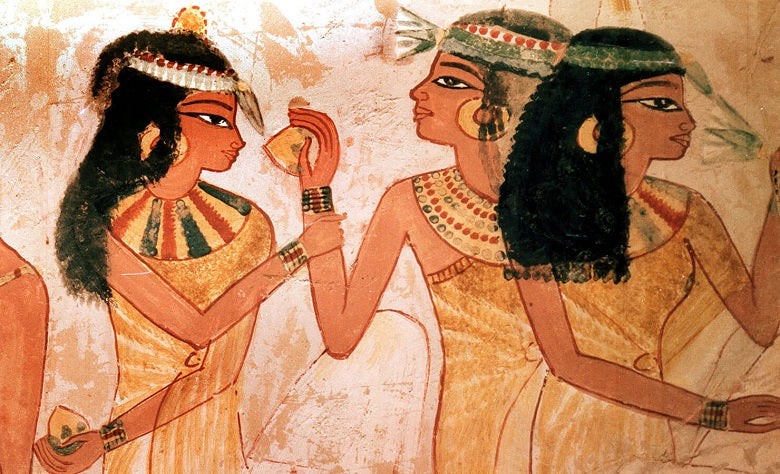
For most of human history, people have used perfume oils to modify the scent of their bodies, but it's also used as a powerful tool to express personality, engage with others, and build self-image. Fragrances accompany us in life each day and are not a new concept. In fact, the use of perfumes and perfume oils goes back several thousands of years. Examples of perfumes have been found in the Roman Empire, ancient Egypt, the Persian Empire, and Mesopotamia. Today, we'll discuss the history of perfume and how it got to where it is today.
The History of Perfume Around the World
People have used perfume for many uses throughout time. Long before it was a fashion industry staple, the nobility would use it to distinguish themselves from others. And, in most cultures, it was only available to the upper class due to being hard to come by and expensive.
Perfume Oils and Ancient Cultures
Ancient Egypt
Perfume oils and fragrances were of great importance for high society Egypt. Even Egyptian mythology references the lord of perfume being the god Nefertem. In many depictions, he's shown carrying water lilies which were commonly found in ancient perfume.
In ancient Egypt, they would make perfume by using non-scented oils to distill other natural ingredients. Most commonly, the scents would be fruity, woodsy, or floral by nature. It's even thought that Egyptian leaders such as Queen Hatshepsut and Queen Cleopatra were fans of fragrances that they'd use to scent their baths, bodies, and quarters. There are even rumors that they took perfume to their graves with them.
Ancient Persia
Those living in ancient Persia were no less captivated by perfumes. This society ruled the perfume trade for decades and is credited with inventing non-oil-based perfumes. Fragrances were held in such high regard with Persian nobility that the Kings often used their very own "signature scents" that no one else was allowed to use.
There's documentation that ancient Persia's perfume-making workshops and equipment were abundant, and they liked to experiment with various distillation processes and scents.
Ancient Rome
The Romans and Greeks of ancient times carefully documented the processes they used to make perfume oils. This is why numerous Greco-Roman fragrances are being remade today, and one of these is from the world's oldest fragrance factory that dates back to 1850 B.C.
Perfume was commonly used for religious purposes, and it played a prominent role in helping Rome transform from a small farming region to a global epicenter. It's estimated that ancient Romans used roughly 550 tons of myrrh and 2,800 tons of frankincense each year. You would commonly find these perfumes in public bathhouses where they were used to scent the water and other body care items such as oils, balms, and fragrances for the hair and skin.
When was Perfume Invented?
The first person on record to make perfume was a chemist lady named Tapputi. The stories of her processes have been found on ancient clay tablets from Mesopotamia, and the writing suggests that she created it in the second millennium B.C.
How was Perfume Originally Made?
In the earliest known times, perfume oils were made from materials such as flowers, bark, leaves, wood, seeds, and roots. There's evidence that it first originated in Mesopotamia and Egypt before arriving in Rome and Persia.
These civilizations would turn these materials into balms that would be used during religious ceremonies or anytime they needed to paint their bodies. Frankincense and myrrh were extracted from trees and used to make incense, while other plants such as peppermint and rose were used to make perfume oils.
As time went on and trade routes expanded, a more extensive selection of scents was available in the form of exotic herbs and spices. Such items were often stilled in water and used to create aromatherapy items.
During these times, perfume bottles were made from clay or wood, but eventually, this changed, and it was placed in beautifully decorated glass bottles.
Early Uses of Perfume Oils
Each culture used fragrances and perfumes for different reasons. Most used them during religious rituals, such as the Egyptians' burial practices, but some also used them to scent bodies and baths.
Perfumes have also been used during purification processes; such is the case in medieval Europe and ancient China. They used fragrances to purify the air to prevent diseases. Some ancient doctors even believed that perfumes could be used medically to treat mental illness and other infections.
Perfume in Today's World

In today's world, perfumes are used by millions of people worldwide as a fashion accessory. These perfumes are made using both synthetic and natural ingredients to create rich fragrances that include complex notes among different layers of scent.
There are literally hundreds of types of perfume and cologne on the market, from celebrity perfumes to timeless classics; there is a scent for everyone! And you'll find that perfumes range in price from relatively inexpensive to ultra-high-end expensive and also come in different levels of concentration.
Thanks to the many perfume vendors across the world, it's highly accessible to the masses and no longer reserved for the noble or wealthy. Wearing cologne and perfume today is a great, subtle way to express your personal style and tastes. Take a look at our collection and find your signature scent today! Check out our Asedos collections below.
